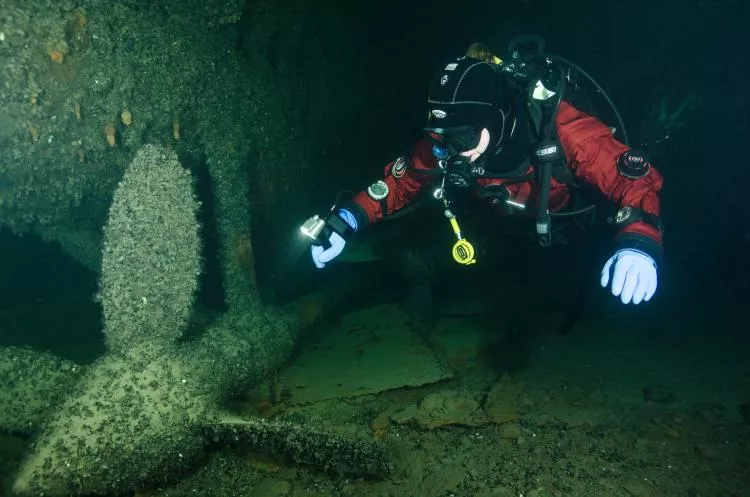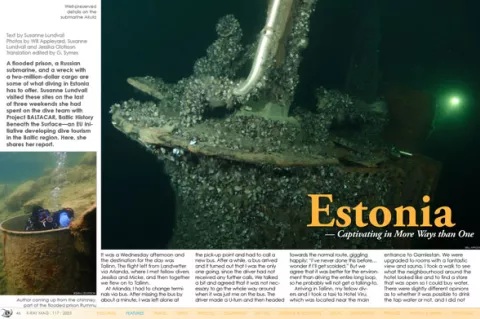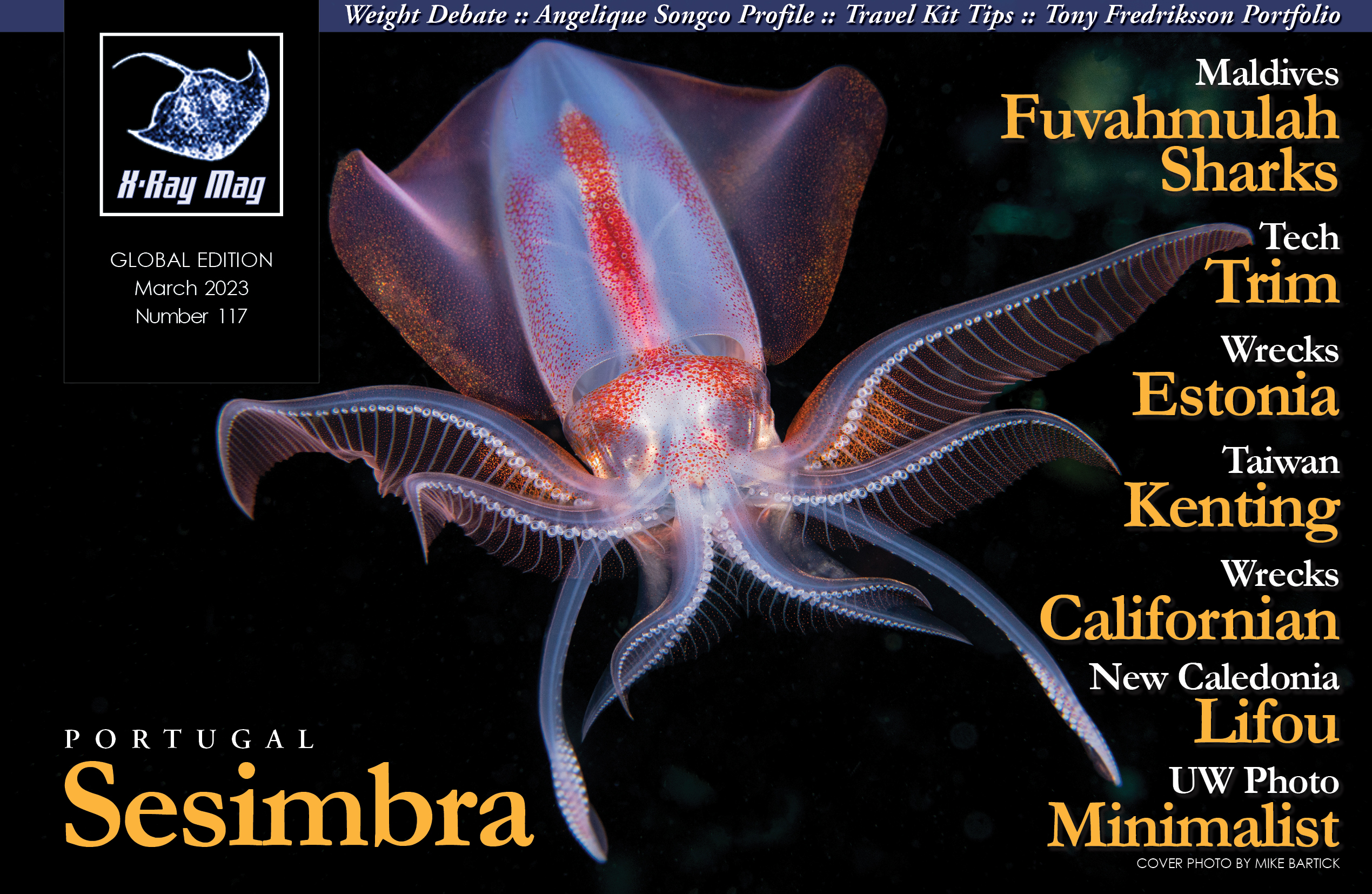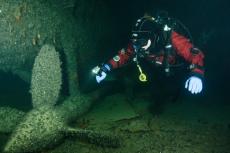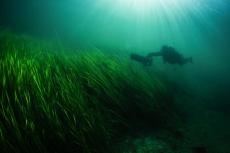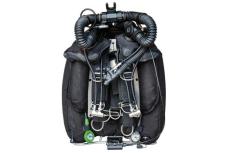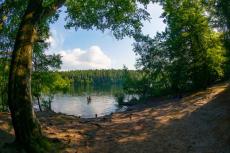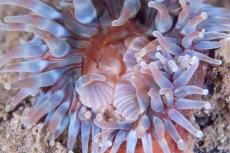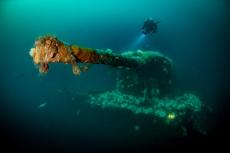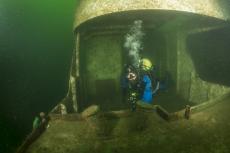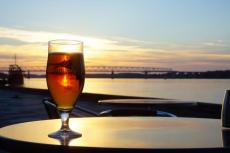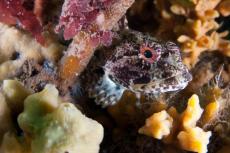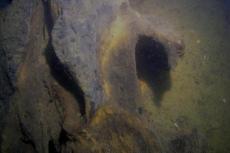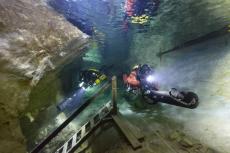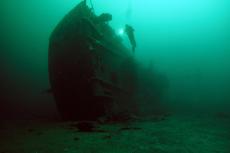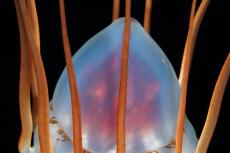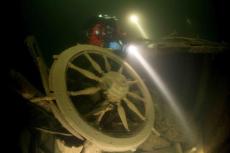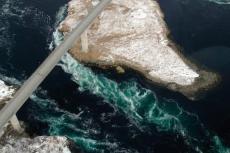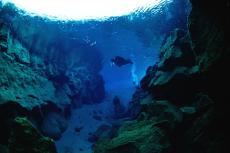A flooded prison, a Russian submarine, and a wreck with a two-million-dollar cargo are some of what diving in Estonia has to offer. Susanne Lundvall visited these sites on the last of three weekends she had spent on the dive team with Project BALTACAR, Baltic History Beneath the Surface—an EU initiative developing dive tourism in the Baltic region. Here, she shares her report.
Contributed by
Factfile
PROJECT BALTACAR
BALTACAR, Baltic History Beneath the Surface, is an EU project that took place 1 January 2017 to 31 December 2019. The project aimed to develop dive tourism and interest in the underwater cultural heritage of the Baltic Sea. This was to be done by developing and simplifying, in practical terms, the ways one could visit the Baltic Sea’s unique and well-preserved wrecks.
Hiiumaa-Dagö
Hiiumaa, which in Swedish is called Dagö, was in Swedish possession from 1563 to 1721. In 1721, the island was conquered by Russia. At the end of the 18th century, there were about 2,000 Swedes there, but when Russia conquered it, about half of these were deported to Ukraine.
Hiiumaa belonged to Russia until 1920, when the island belonged to the newly proclaimed Republic of Estonia and was then occupied by the Soviet Union in 1940. Hiiumaa was then occupied by the Soviet Union until 1991. It has a lot to offer the history buff.
Hiiumaa is Estonia’s second-largest island and is one of the oldest islands in the realm. There are approximately 8,300 people living on the island, and its largest city is Kärdla. The island is incredibly picturesque, has fantastic sandy beaches and is perfect for nature lovers.
The wrecks around Hiiumaa
All six wrecks in the Estonian part of the EU project BALTACAR are marked with a yellow buoy and are therefore relatively easy to locate.
HMS Myrtle was a Scottish minesweeper built in 1915. She sank on 15 July 1919 as a result of an explosion caused by a German minefield. Six of a total of 79 crew members perished. The wreck is 76m long and ten metres wide and lies at a depth of 28 to 34m.
Shchit was a 53m-long minesweeper built in Tallinn in 1916. On 6 December 1916, it struck a mine and slowly sank. All 38 of the crew, and also important documentation, were saved aboard the minesweeper Gruz. The wreck is spread over an area of 33 by 44m and lies at a depth of 11 to 13m.
Altair was a minesweeper built in Papenburg, Germany, in 1916. It was 37m long and 7.1m wide. On 14 October 1917, Altair entered a Russian minefield, and in the explosion, was split in two. Ten of the crew’s 31 men perished. The wreck was torn apart in the explosion, so of its original 37m length, only 15 metres remain. The wreck lies at a depth of 24 to 28m.
The submarine Akula was built in Saint Petersburg, Russia, in 1906-1909. It was 56m by 3.7m by 3.4m in dimension and had a maximum diving depth of 50m. On 15 November 1915, it hit a mine and sank, together with all 35 crewmen on board. The wreckage was scattered over an area of approximately 40m by 4m, at a depth of 24 to 30m.
The minesweeper No 1 was built in 1892 at W. Lindbergs shipyards in Stockholm. It was built as a freighter and named Linnea. It operated in Finnish waters until World War I in 1914, when it was rebuilt as a minesweeper and given the name No 1. On 16 September 1915, it struck a mine laid by the German submarine UC-4 and sank. All of the crew survived. The wreck is divided into two parts and has a total length of 6m, with a width of 8m. It lies at a depth of 14 to 18m.
E. Russ was a steam freighter built in Germany in 1909 and subsequently gifted to England in 1919. On 15 September 1919, it was en route from Bordeaux to Tallinn when, north of Hiiumaa, it struck a floating mine. After 15 minutes, it sank, but all 27 crewmen and eight passengers survived. The wreck is 94m long and 14m wide and lies at a depth of 24 to 36m.
COLLABORATIVE PARTNERS:
Rummu Underwater Prison Barrakuuda Dive Club (barrakuuda.ee) Adventure Center (rummu.eu/en) Hiiumaa Renovated military 200-boat Deep Explorer is operated by Technical Diving Estonia (Facebook)
LODGING & DINING:
Tallin Hotel Viru (sokoshotels.fi) Hiiumaa Viinaköök old distillery (viinakook.com) Resto Les & Lammas (hiiumaale.ee) For more information about Project BALTACAR, visit: projectbaltacar.eu
It was a Wednesday afternoon and the destination for the day was Tallinn. The flight left from Landvetter via Arlanda, where I met fellow divers Jessika and Micke, and then together we flew on to Tallinn.
At Arlanda, I had to change terminals via bus. After missing the bus by about a minute, I was left alone at the pick-up point and had to call a new bus. After a while, a bus arrived and it turned out that I was the only one going, since the driver had not received any further calls. We talked a bit and agreed that it was not necessary to go the whole way around when it was just me on the bus. The driver made a U-turn and then headed towards the normal route, giggling happily: “I’ve never done this before… wonder if I’ll get scolded.” But we agree that it was better for the environment than driving the entire long loop, so he probably will not get a talking-to.
Arriving in Tallinn, my fellow divers and I took a taxi to Hotel Viru, which was located near the main entrance to Gamlestan. We were upgraded to rooms with a fantastic view and sauna. I took a walk to see what the neighbourhood around the hotel looked like and to find a store that was open so I could buy water. There were slightly different opinions as to whether it was possible to drink the tap water or not, and I did not want to take a chance and risk ruining the dive weekend. But I should not have worried. Drinking the tap water in Estonia was no problem at all.
Rummu, a flooded prison
On Thursday morning, after a lovely hotel breakfast and a morning walk in Gamlestan, we were picked up by car at the hotel. The old quarters were great, and I would love to return to Tallinn and spend some more time there.
The approximately one-hour drive headed towards the southwest and the Rummu prison, which was in use until 2012. The prisoners worked in the now-flooded limestone quarry. As the limestone was fractured, the fracture filled with water. Pumps ensured that the breach did not fill with water as long as it was in use. When the prison was closed and the inmates were moved, the pumps were also turned off, so that part of the prison filled with water. It was now a completely unique place to dive.
The guide gave a briefing about the dive site, and we were divided into two groups. The water in the breach was clear and maintained a temperature of around 18°C, which was significantly warmer than the sea. So, I left my thick undergarment behind on land.
Diving here was a completely new and literally captivating experience for me. The underwater landscape was completely different from what I had seen before. At a depth of five metres there were still trees to be seen. It felt as if I was diving into a forest, and one could still see the paths. I even saw something that looked like a pond. There was a thin layer of white fog, and it seemed as if it was a land of fairies in a forest grove on an autumn morning.
We swam over the prison wall, where the barbed wire still remained at the top of the wall, and on towards buildings with bars for the windows. We did not know for sure what they were used for, but they were large surfaces, good visibility and easy to swim in. Clothes, tools and other equipment, such as a wheelbarrow, remained next to the buildings. We also swam past the occasional perch and pike.
After we paused and watched for a while, and our fellow diver Will Appleyard managed to take some pictures, we noticed that the dive guide was gone. When diving with a photographer, it tends to take some time, which I do not mind at all. But the guide apparently thought we were too slow.
On the way to the next building, the guide reappeared and showed us a chimney adjacent to the house. He had previously said that it was fine to swim, or rather climb, through it, as the cast steps were still there.
We were in the water for a full 90 minutes, during this very fascinating dive. Rummu had something for every kind of diver. It was shallow (the maximum depth in the limestone quarry was 12m), with good visibility and warm water most of the year. If one wanted to stay at the surface, there were also snorkel trails and the possibility to rent kayaks and stand-up paddleboards (SUPs).
After packing the equipment into the car, we got a guided tour of Murru—the part of the prison that was not underwater. The cells were dark and cramped. There were a few personal belongings left here, as well as posters on the walls. To think that people had been locked up in here recently, just over a decade ago... It felt like we had travelled at least 100 years back in time.
Hiiumaa
After just over an hour’s boat ride from Rohuküla on the mainland, we arrived at the island of Hiiumaa, which in Swedish is called “Dagö.” We stayed together in the old Viinaköök distillery, which was about 40 minutes by car from the Heltermaa ferry stop. It was windy, which it apparently often is on Hiiumaa, so our first boat dives were blown out, unfortunately. So, we decided instead to do some sightseeing on the island.
We visited a military museum and two lighthouses. The Tahkuna lighthouse was located as far north as one could get, and the Kopu lighthouse, which dated to the 16th century, was one of the world’s oldest lighthouses. It was located on the western tip of the island.
The next day, it was finally time to dive in the Baltic Sea again. It was still windy, so I came prepared with motion sickness tablets. We headed to the port, where the old military 200 boat was waiting for us. The Deep Explorer dive boat was rebuilt and well-adapted for divers. Among other things, it was equipped with a lifting device at the stern, so when you had to get onto the boat, you swam into the “elevator” and then easily winched up. So luxurious! No climbing a dive ladder in high seas here! We assembled our kit and donned our drysuits, to get ourselves as ready as possible while still in port.
E. Russ
The first dive was on E. Russ, which was an English steam freighter built in Germany in 1909. On 15 September 1919, it was en route from Bordeaux to Tallinn, but struck a floating mine north of Hiiumaa. After 15 minutes, it sank, but all 27 crewmen and eight passengers survived. The wreck was 94m long and 14m wide and rested at a depth of 24 to 36m.
On the way out to the wreck, the waves really rocked the boat, but I thought that once I was in the water, I would feel much better. We submerged, and for the first few meters there was—just as the dive guide and captain had prepared us for—very poor visibility. But once down on the wreck, the visibility was fantastic. We could see at least 25 metres of the 94m-long wreck.
We made our way aft, to get an overview of the wreck and the cargo. E. Russ had, when it left Bordeaux, a cargo valued at two million dollars. The ship was full of food, cigarettes and alcohol, and also around 50 cars, motorcycles and spare parts. About half of the cargo was salvaged. However, we did see some car parts, shoes and tools. The wreck had a lot to offer and actually requires two to three dives, preferably on nitrox, in order to have enough time to see everything.
Akula
When it came time to plan for dive number two, we considered whether we should do a second dive on E. Russ or sail about an hour west to another wreck. Since the wind had started to break up and the sea had calmed down, and we needed a surface interval, we made the decision to go to the Russian submarine Akula.
Akula was built in 1906 in Saint Petersburg, Russia. It was completed in 1909 and was equipped with three diesel engines, with a total of 900 hp, as well as eight torpedoes.
It was Russia’s first submarine and made to handle longer trips—to Japan, among other places. Its maximum speed was 16 knots at the surface, 7 knots at depth, with a diving depth of 50m. On 15 November 1915, Akula was out on its 19th mission with a crew of 35 men. The assignment was to lay out four mines. However, Akula did not have time to lay any mines before it ran into one itself. Akula went to the bottom with its entire crew.
Will and I were ready quickly, so first in the water. Again, it was a green, swaying soup for the first few metres. Then, it eased up and there was really good visibility. We were on the descent line when suddenly the wreck of Akula appeared out of the darkness.
We swam out towards the submarine tower and looked out over the apparently quite intact submarine—it was mighty! We could see 25 metres of the 40m submarine, so it was easy to navigate. Will signalled to me that he wanted us to go down to the four propellers at a depth of 30m on the starboard side. Will took some photos, and we swam around for a further look. The submarine’s cladding was in very good condition, and there was basically no rust at all.
After 30 minutes, we saw our Finnish friends arrive, whereupon Will felt satisfied with the dive and signalled that he wanted to ascend. Since I had plenty of air and time left, I decided to check with our Finnish dive buddies if I could continue the dive with them. No problem! So, I continued to explore the submarine for a while longer. At the safety stop, I could not help but give the 35 crewmen who went down with Akula into the depths, and their families, a thought.
It was a powerful dive that ended three fantastic weekends in the Baltic Sea—three weekends filled with experiences marked by history. The adventure was my first time diving the Baltic Sea, but definitely not my last. I, who normally love to dive in warm waters with lots of fish, must admit that this was beyond my expectations. With all the history surrounding it, the Baltic Sea was much more fascinating than I could ever have imagined.

